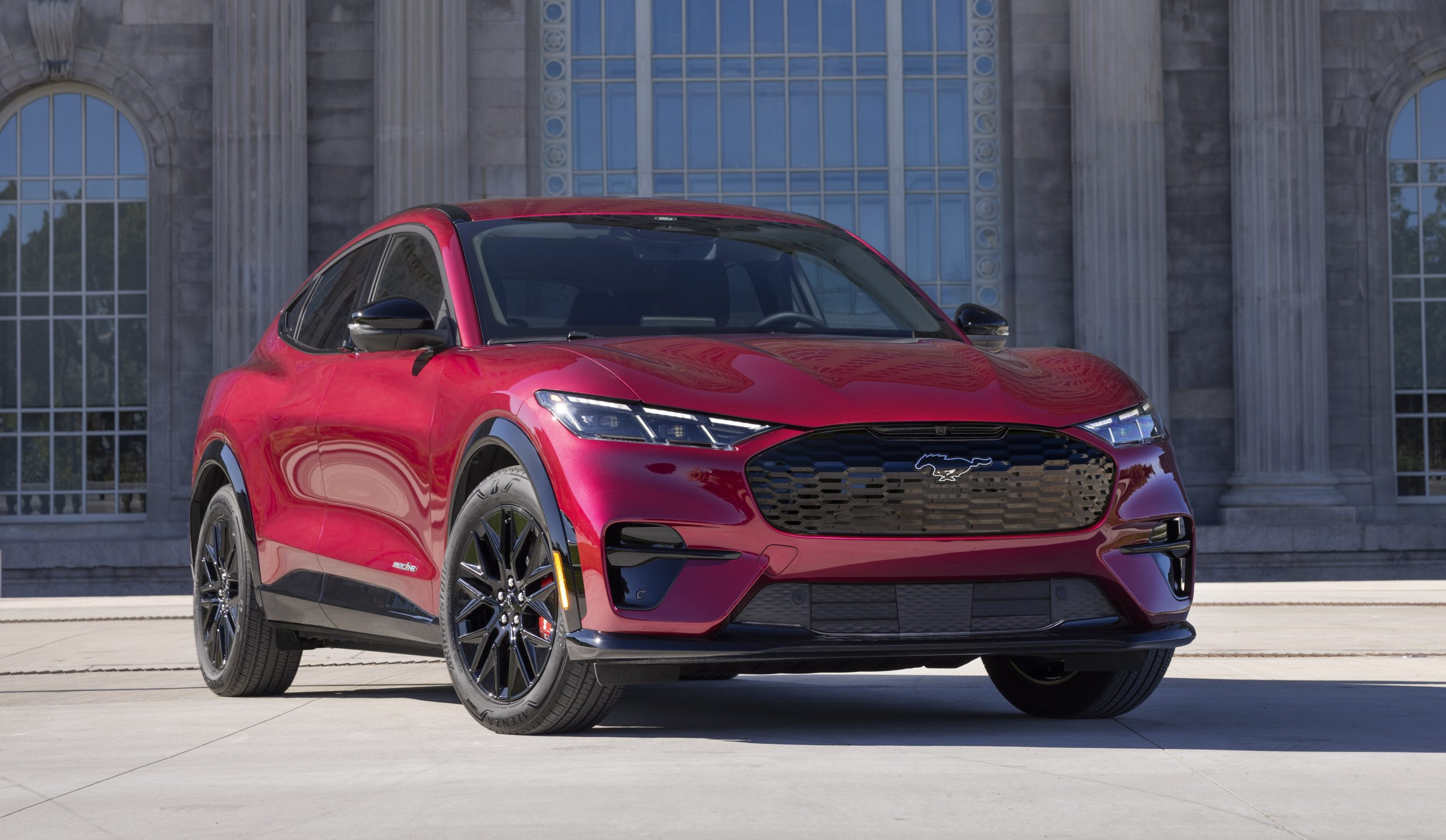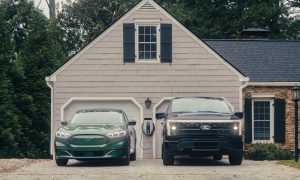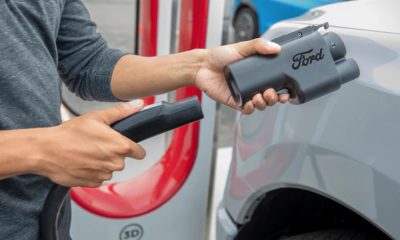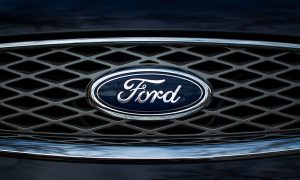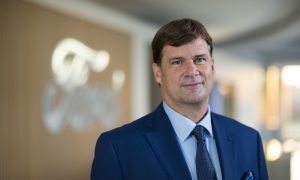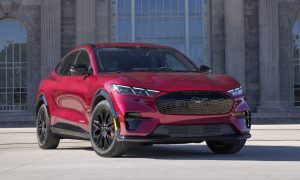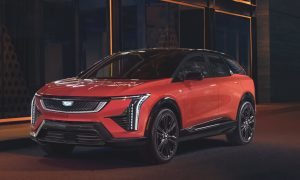The U.S. is set to grant a more-than $9.6 billion loan to Ford and a partner for the construction of new electric vehicle (EV) battery manufacturing plants, with the country’s top energy agency this week saying that it has finalized the offer.
On Monday, the U.S. Department of Energy (DOE) announced that it has finalized a $9.63 billion loan for Ford and South Korean company SK On, set to help the companies establish three brand-new battery production facilities in Kentucky and Tennessee, as reported by Reuters. The BlueOval SK joint venture is the largest loan ever to come from the agency’s Advanced Technology Vehicles Manufacturing loan program, coming from the Biden administration ahead of Donald Trump taking office in January.
The companies plan to begin construction on the first Kentucky factory in 2025, with the Tennessee facility expected to follow later in the year. This funding is expected to eventually support the production of 120 GWh of EV batteries per year, and as the U.S. seeks to bolster its domestic supply chain for batteries and reduce its reliance on China.
In an interview with the head of the DOE loan program, Jigar Shah, the agency official highlighted the importance of the loan enabling U.S. jobs, and promoting local production of EV batteries.
“This program is essential to getting people to choose the United States of America,” Shah said. “When you look at the competition that we have from China, it is very clear to me that they have used low-cost debt for a very long time to promote a lot of manufacturing capacity that has hollowed out many communities in Kentucky, Tennessee, and other states around the country.”
READ MORE ON DEPT. OF ENERGY: Rivian gains conditional $6.6B loan commitment for Georgia factory
The DOE initially offered a conditional commitment of $9.2 billion for the Ford JV loan, and some have criticized the process taking almost 18 months since the plan was approved in June 2023. Blue Oval SK has responded to criticisms of the lengthy process by saying that the department went through rigorous due diligence to finalize the loan, including thorough reviews of the financial, technical, legal, market, credit, and regulatory implications.
Ford also has a battery supply deal in place with fellow Korean battery supplier LG Energy Solution (LGES) for the European and North American markets, and part of the agreement includes bringing battery production for the Mustang Mach-E to the U.S. In its third-quarter earnings call, Ford reported a $1.2 billion loss on EVs, saying that it expects to reach a full-year loss of roughly $5 billion as it aims to achieve profitability with the sector.
What are your thoughts? Let me know at zach@teslarati.com, find me on X at @zacharyvisconti, or send us tips at tips@teslarati.com.
Need accessories for your Tesla? Check out the Teslarati Marketplace:
News
Waymo kicks off initial tests in Japan with launch event
Waymo launches early tests in Japan, as Tesla and others look to roll out their own commercial robotaxi services.
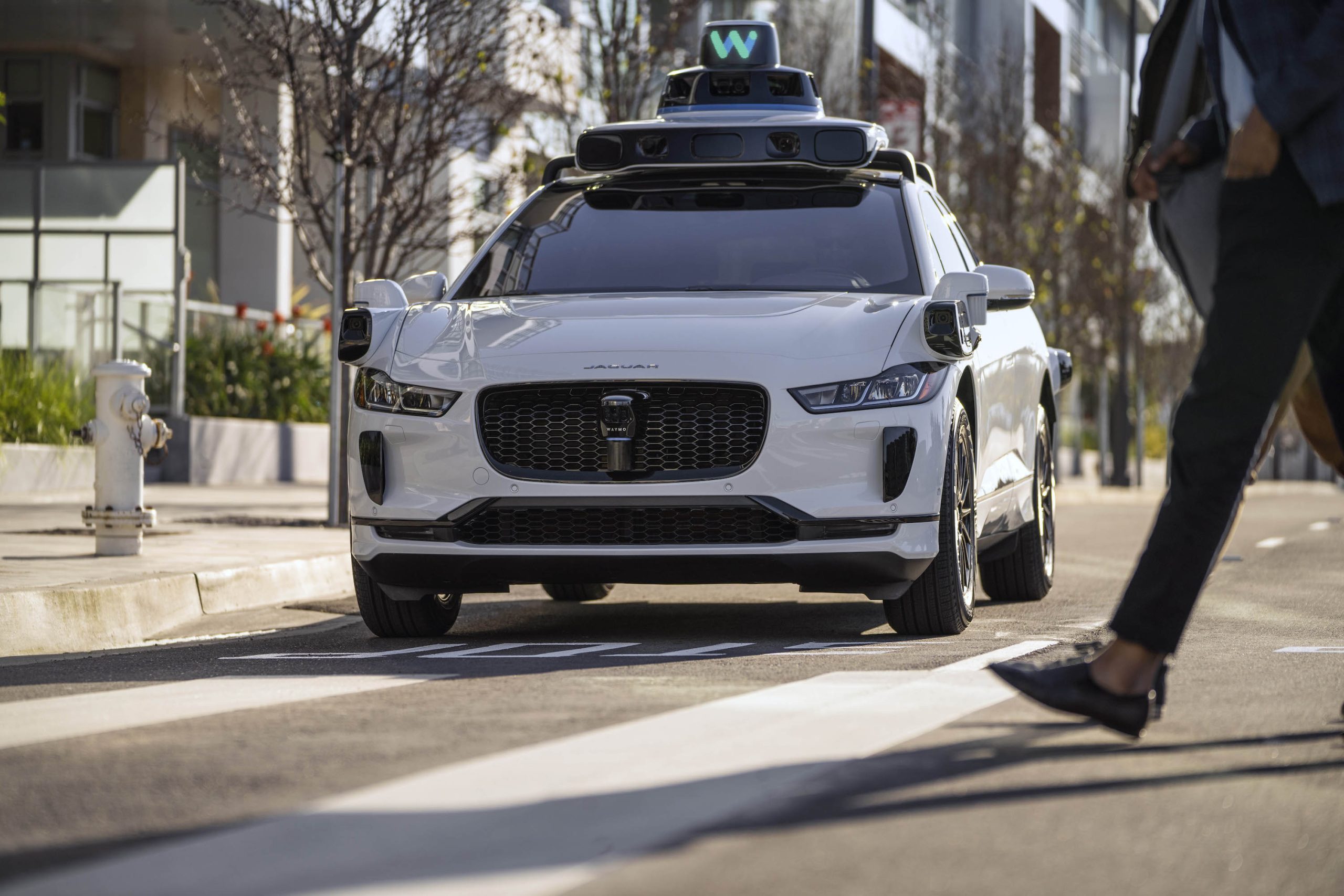
Commercial robotaxi company Waymo held a launch event in Japan last week, as the company prepares to enter early manual testing on its first international roads.
After Waymo shared plans to start testing vehicles in Japan in December, the Google-owned firm detailed the launch event in a press release on Monday. The event featured officials from project partners GO, a taxi platform, and Nihon Kotsu, the largest taxi company in Tokyo, along with featuring one of the company’s camera-, lidar-, and radar-outfitted Jaguar I-Pace units, expected to begin manual testing around Tokyo in the weeks to come.
Ichiro Kawanabe, Board Director at Nihon Kotsu and Chairman at both GO and the Japan Taxi Association, said that Waymo’s U.S. operations “demonstrated significant safety benefits,” along with thanking the company for hosting the event at the newly developed Takanawa Gateway City complex.
“I took my first ride with Waymo in Phoenix a year and a half ago and was amazed that there was really no one in the driver’s seat,” the chairman said. “That was the moment I was convinced that autonomous driving technology could absolutely benefit Japan. It will help ensure mobility service in the future of Japan, with the growing aging population and labor shortage.”
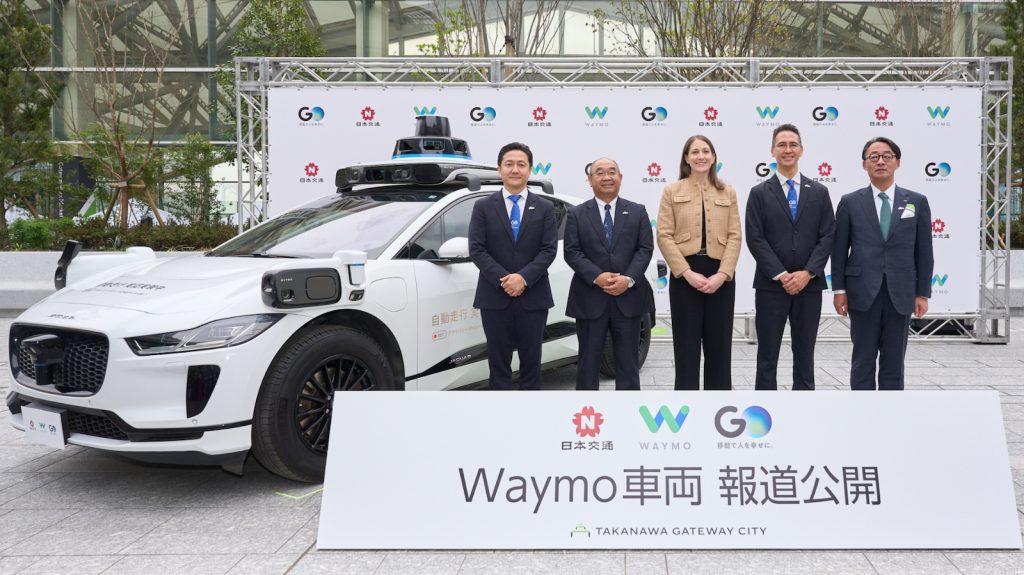
Credit: Waymo
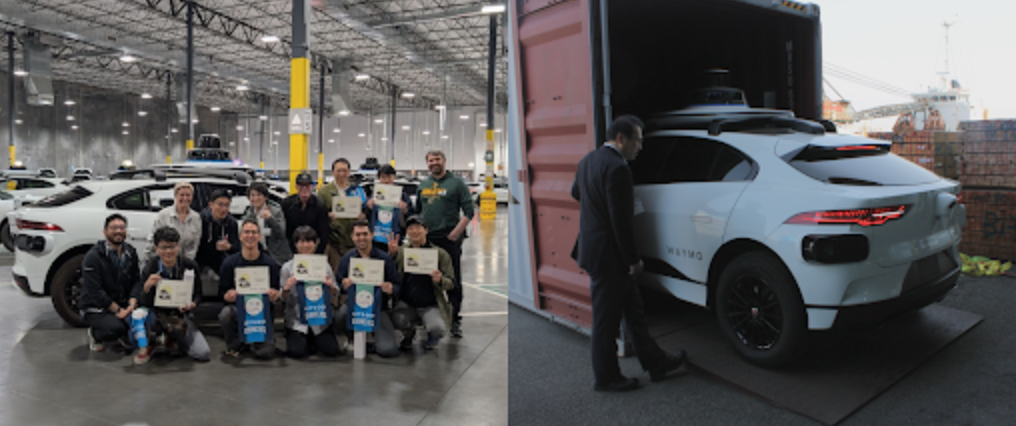
Credit: Waymo
This spring, Nihon Kotsu taxi operators will start driving Waymo vehicles across several Tokyo wards this spring, including Chiyoda, Chūō, Kōtō, Minato, Shibuya, Shinagawa, and Shinjuku. The tests will utilize 3D maps of the city, along with utilizing experienced drivers to generate data about traffic laws, patterns, and other road systems ahead of fully autonomous operation.
“After months of strong collaboration with Nihon Kotsu and GO, Waymo has reached a historic milestone— our first venture on international public roads,” said Nicole Gavel, Waymo Senior Director and Head of Business Development and Strategic Partnerships.
“Our partnership demonstrates how Waymo’s 15 years of operational expertise can adapt to new environments through strategic initiatives with industry leaders,” Gavel adds. “In Tokyo, we are abiding by the same steadfast principles that guide us in the U.S. — commitment to safety, dedication to earning trust in communities where we operate, and collaboration with local officials and community groups here in Tokyo.”
The news comes as Tesla, Amazon-owned firm Zoox, and still others are racing to enter the commercial robotaxi business throughout this year. It also comes amidst widespread speculation and debate about the emerging market, and as Tesla and Waymo both aim to begin operations internationally.
READ MORE ON WAYMO: Waymo study analyzes collisions with vulnerable road users
Tesla’s FSD in China, Mexico, commercial robotaxis still incoming
Waymo is already operating paid autonomous ride-hailing services around the U.S., and it said in December that it was giving more than 200,000 autonomous rides per week.
The company currently offers Waymo services in San Francisco and Los Angeles, California, Phoenix, Arizona, and, through a partnership with Uber, in Austin, Texas, where Tesla has a Gigafactory and plans to launch initial robotaxi services. The Alphabet-owned company is also aiming to launch services in Atlanta, Georgia and Miami, Florida this year, alongside its early tests in Tokyo.
Although Tesla doesn’t currently operate driverless ride-hailing in any capacity, individual owners in North America can purchase or subscribe to its Supervised Full Self-Driving (FSD) system, on which the company’s forthcoming robotaxi platform will be based. In October, the company unveiled the two-seat Cybercab vehicle, which has no steering wheel or pedals and will be used for the upcoming commercial robotaxi system.
Additionally, the company is aiming to launch its first unsupervised rides commercially in Austin in June, and it recently debuted Supervised FSD in China and Mexico, marking the company’s first international markets.
🎥: Our FULL first ride in the @Tesla Cybercab pic.twitter.com/6gR7OgKRCz
— TESLARATI (@Teslarati) October 11, 2024
Waymo vs. Tesla vs. the competition
While Tesla hasn’t quite gotten a commercial robotaxi service to market yet, Waymo, Amazon-owned company Zoox, and still many others have begun their own paid ride-hailing services or early tests. Meanwhile, Tesla’s approach to the technology is vastly different than that of Waymo and others, utilizing a camera-only, AI-trained neural network system, rather than 3D geomapping.
For one, the company can generate a larger pool of training data from real-time driving behavior of its individual owners, for instance as compared to Waymo’s use of a more-limited fleet of taxi drivers. Many argue that this, along with the cost-effectiveness of producing a system that’s built into every vehicle and utilizes only cameras, make the system more scalable than those of Waymo and others.
Still, some support the use of more than just camera systems and building in sensor redundancy as a way to maximize safety, especially as the technologies are still fairly new. Former Waymo CEO John Krafcik, who was a part of the company until 2021, criticized the FSD system in December for not including enough safety measures to support a realistic commercial robotaxi business, and he went on to call Tesla “a car company with a driver-assist system.”
“If a company were serious about building a safe and accessible robotaxi business, it would look nothing like what was shown,” Krafcik said during an interview. “The cost of a robust sensor set, including lidar, is trivial on a per-mile basis. Even more so for mapping. And the safety benefits measured in human harm reduction are real and verifiable.”
Waymo valued at over $45 billion following latest financing round: report
News
Nvidia starts production on first AI supercomputers built in U.S.
One Nvidia factory in the U.S. has already come online, while two others are expected to reach mass production in 12 to 15 months.
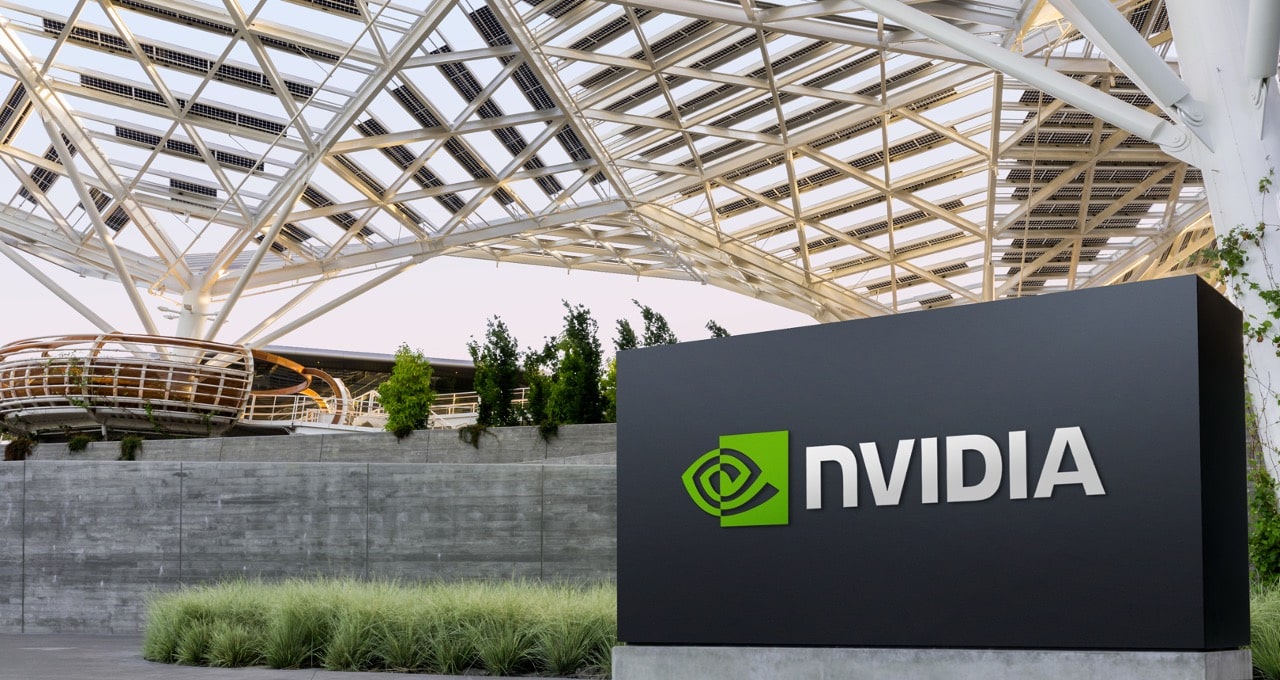
Chip manufacturer Nvidia has officially started production of AI supercomputers at multiple U.S. factories operated through partnerships, marking the first such hardware to be built within the country.
On Monday, Nvidia announced that its Blackwell chips have begun production at a factory operated in partnership with TSMC in Phoenix, Arizona, as detailed in a press release. The chip maker also continues to work on the construction of two future factories to be operated in Texas, in partnership with Foxconn in Houston and Wistron in Dallas.
Nvidia says that mass production of the Blackwell GPUs is expected to ramp up at both Texas facilities within the next 12 to 15 months, together with the Arizona factory representing a total of over a million square feet of U.S. manufacturing space.
“The engines of the world’s AI infrastructure are being built in the United States for the first time,” said Jensen Huang, Nvidia Founder and CEO. “Adding American manufacturing helps us better meet the incredible and growing demand for AI chips and supercomputers, strengthens our supply chain and boosts our resiliency.”
The manufacturer also says that it aims to produce up to $500 billion worth of AI infrastructure in the U.S. within the next four years, through these partnerships and others with Amjor and SPIL. Nvidia also expects the facilities to create hundreds of thousands of jobs, along with driving trillions of dollars in economic security in the decades to come.
NVIDIA CEO Jensen Huang talks about Elon Musk’s prowess in AI across his several companies:
— TESLARATI (@Teslarati) January 7, 2025
READ MORE ON NVIDIA: Elon Musk explains reasoning for Nvidia chip re-route from Tesla to X
Blackwell chips were designed for use in high-powered AI data center applications, and the news comes as Elon Musk’s xAI, Tesla, and several other companies are working to expand their infrastructure for supercomputing. It also comes amidst an ongoing tariff war launched by the Trump administration, which is expected to hit a wide range of products, including semiconductor chips.
Musk estimated last year that Nvidia purchases would comprise roughly $3 to $4 billion of Tesla’s $10 billion AI expenditures, and the company spent much of the year constructing a massive supercomputing cluster at its Gigafactory in Texas. The location houses 50,000 Nvidia H100 supercomputing chips, used to help train Tesla’s Full Self-Driving (FSD) system, and Musk also said last June that the facility’s power needs would increase from 130MW to over 500MW in around 18 months.
Additionally, Musk’s xAI began operations at a Memphis, Tennessee facility with 100,000 Nvidia H100 and H200 units last July, and the site is in the process of being expanded to 200,000. Nvidia was also a strategic investor in a $6 billion Series C investment into xAI, alongside fellow GPU manufacturer AMD.
Weeks before the funding was announced in December, it was also reported that xAI had gained a $1.08 billion priority Nvidia order of GB200 AI servers, after Huang was personally approached by Musk.
News
Underrated Tesla safety feature recognized by China Automotive Research Institute
Teslas are not just safe from electromagnetic radiation—they are among the safest vehicles in the market when it comes to radiation protection.

Electric vehicles like Tesla have become very common today, but this does not mean that they are immune to misinformation campaigns. One of these points of FUD (fear, uncertainty, and doubt) relates to EVs’ alleged electromagnetic radiation, which is supposedly a potential heath risk.
As per the China Automotive Research Institute, however, Teslas are not just safe from electromagnetic radiation—they are actually some of the safest vehicles in the market when it comes to radiation protection.
Tesla Model 3 and Model Y’s Results
As per Tesla China VP Grace Tao in a post on Weibo, the idea that electric vehicles expose occupants to electromagnetic radiation is a product of misinformation. As per the Tesla executive, the Model 3’s magnetic field strength near the driver and passenger’s head in the cabin only reaches 0.08-1.30μT, which is far lower than the magnetic field one would be exposed to if they use a conventional electric blanket.
“Taking Model 3 as an example, the magnetic field strength near the driver and passenger’s head in the car is only 0.08-1.30μT. In most cases, the magnetic field strength of an electric blanket close to the body is about 10-50μT, which is tens or even hundreds of times the strength inside a Tesla car, so car owners can rest assured,” Tao wrote in her post.
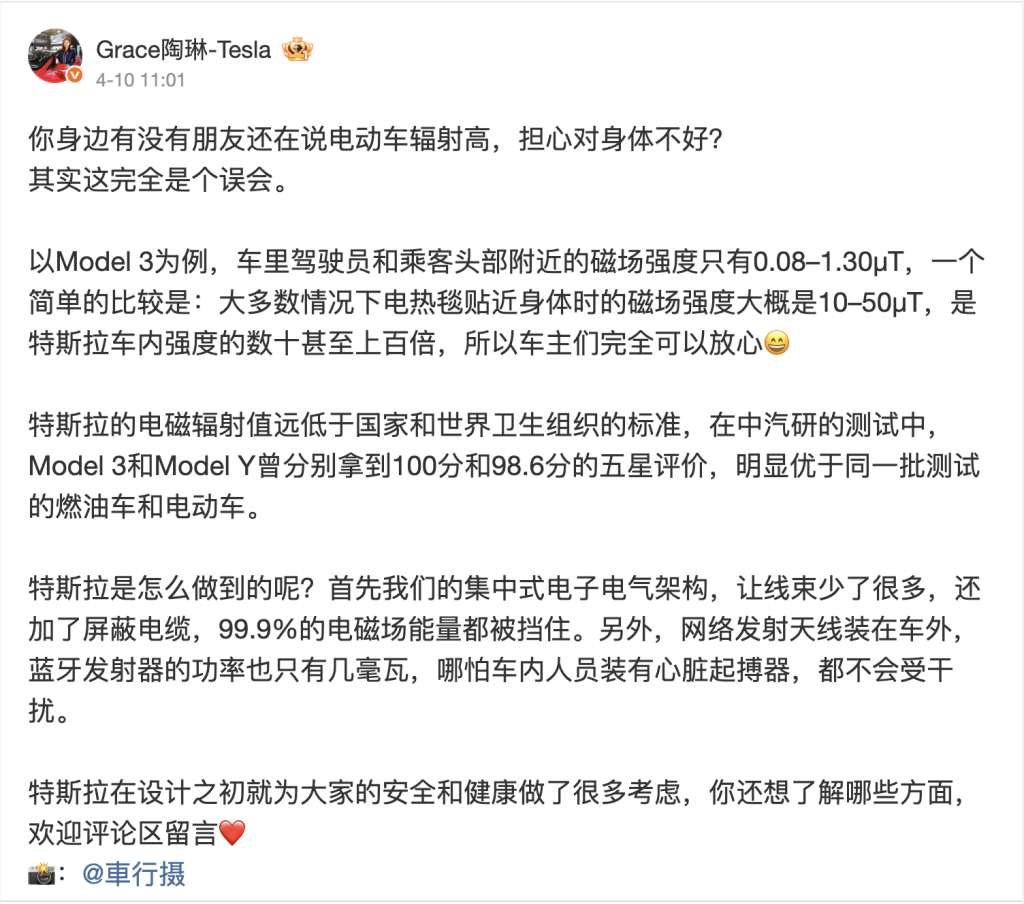
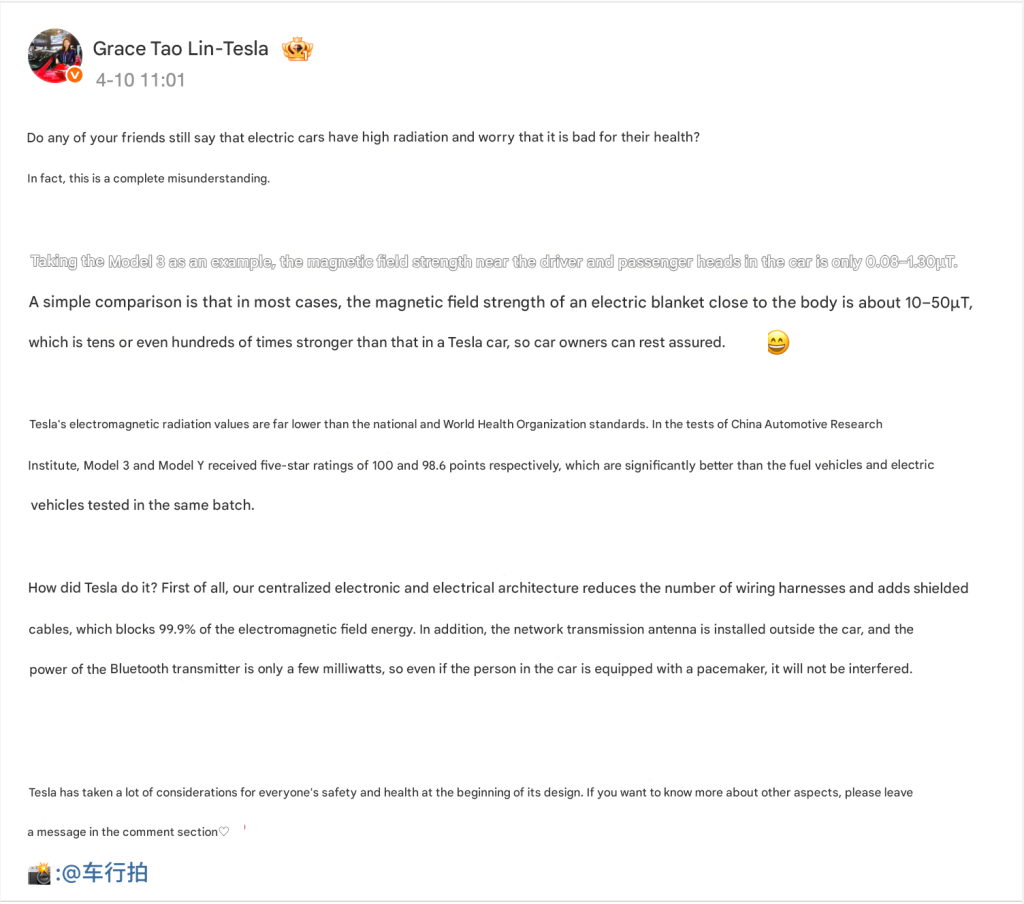
Beyond Standards
The Tesla VP added that the electromagnetic radiation values of Tesla’s vehicles are far lower than national and World Health Organization standards. During tests from the China Automotive Research Institute, the Model 3 and Model Y received five-star ratings of 100 and 98.6 points, which were notably better than combustion-powered cars and other electric vehicles that were tested in the same batch.
Tao explained how Tesla was able to achieve these scores below:
“How did Tesla do it? First of all, our centralized electronic and electrical architecture reduces the number of wiring harnesses a lot, and shielded cables are added, blocking 99.9% of the electromagnetic field energy. In addition, the network transmission antenna is installed outside the car, and the power of the Bluetooth transmitter is only a few milliwatts, so even if the people in the car are equipped with pacemakers, they will not be interfered with,” the Tesla VP wrote.
-
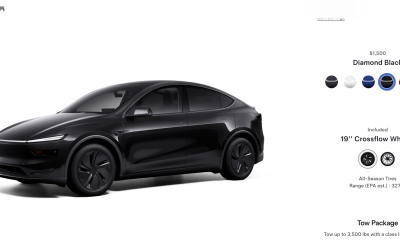
 News1 week ago
News1 week agoTesla rolls out new, more affordable trim of the Model Y Juniper in U.S.
-
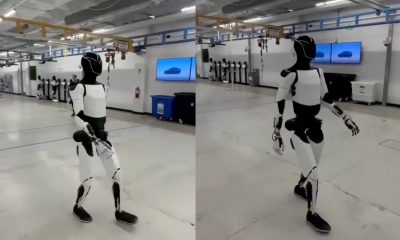
 News2 weeks ago
News2 weeks agoTesla shares Optimus’ improved walk in new update video
-
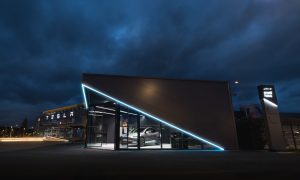
 Elon Musk2 weeks ago
Elon Musk2 weeks agoTesla Germany reports 4,935 units sold in Q1 2025
-
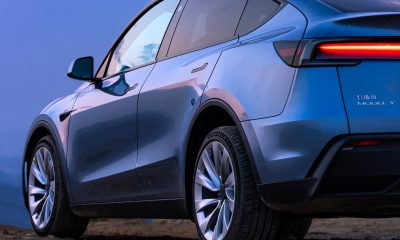
 Investor's Corner2 weeks ago
Investor's Corner2 weeks agoTesla (TSLA) shares company-compiled Q1 2025 delivery consensus
-
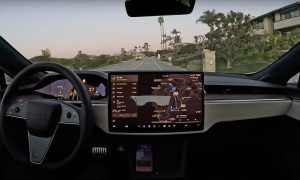
 News1 week ago
News1 week agoTesla expands Early Access Program (EAP) for early Full Self-Driving testing
-

 Elon Musk2 weeks ago
Elon Musk2 weeks agoNYC Comptroller moves to sue Tesla for securities violations
-
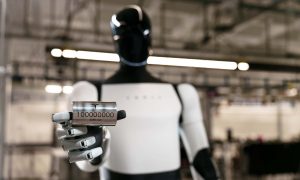
 News1 week ago
News1 week agoTesla celebrates key milestone for 4680 battery cell production cost
-
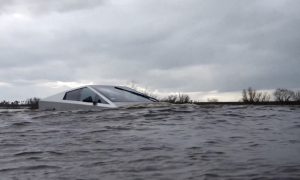
 News2 weeks ago
News2 weeks agoTesla’s Elon Musk reiterates ambitious Cybertruck water update

